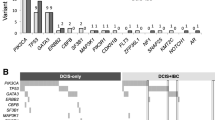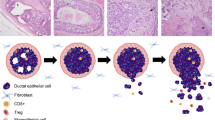Abstract
The main reason for the recent interest in p53 is that almost 50% of human cancers contain p53 gene mutations. The majority of studies on p53 alterations in breast cancer have been limited to the isolated cases of ductal carcinoma in situ and infiltrating ductal carcinoma. The aims of this study were to determine the status and timing of p53 mutation in the progression from atypical ductal hyperplasia to invasive cancer, and to evaluate the patterns of p53 mutations in noninvasive and invasive lesions. Available lesions of invasive (n=88) and noninvasive (n=76) lesions were microdissected in 107 paraffin-embedded tissues (19 ductal carcinomas in situ, 57 invasive carcinomas with intraductal components, and 31 pure invasive carcinomas) and double-strand DNA sequencing was performed in exon 4–9 of the p53 gene. Among in situ cancers without invasive disease 36.8% had p53 mutations whereas in situ cancer with concurrent invasive disease showed p53 mutations in 33.3% of cases. In particular, two of seven atypical ductal hyperplasias harbored p53 alterations (one insertion and one missense mutation) in exon 8. The invasive component harbored p53 mutations in 30 of 88 cases (34.1%). We also discovered a novel deletion of 14 bp in exon 6 of two invasive lesions. The invasive component (1.33±0.13) carried a greater number of p53 mutations than its counterparts (1.19±0.10) and demonstrated more frequent multiple mutations (23.3% vs. 15.4%), but without statistical significance. Moreover, no statistical significance could be attached to the mutation frequency in the zinc-binding domains (26.7% vs. 15.4%), the directly DNA contact region (13.3% vs. 15.4%) and the missense mutation of p53 (50.0% vs. 57.7%) of the two groups. Based on our results, in spite of the small number of the lesions investigated, p53 mutation can occur at the stage of atypical ductal hyperplasia. The hypermutability and the specific p53 mutations involving the biologically functional domain (e.g., zinc binding domain or DNA contact region) have an insignificant influence on invasive progression in the breast cancer.
Similar content being viewed by others
Author information
Authors and Affiliations
Additional information
Electronic Publication
Rights and permissions
About this article
Cite this article
Kang, J., Kim, S., Noh, DY. et al. The timing and characterization of p53 mutations in progression from atypical ductal hyperplasia to invasive lesions in the breast cancer. J Mol Med 79, 648–655 (2001). https://doi.org/10.1007/s001090100269
Received:
Accepted:
Published:
Issue Date:
DOI: https://doi.org/10.1007/s001090100269




